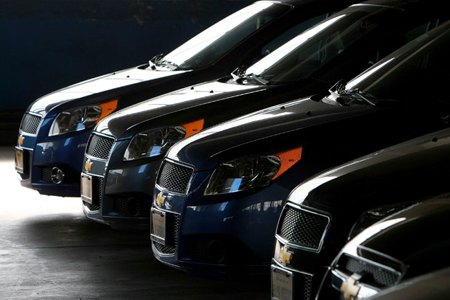CSFB: ChryCo Dealers Overstocked by 40%, GM 31%
Credit Suisse First Boston (CSFB) has had a look at Chrysler, Ford and GM inventories vs. the Seasonally Adjusted Annual Rate of Sales (a.k.a. SAAR), and it’s even uglier than we thought. Given that The Big 2.8 have already cut WAY back on production AND increased incentives, it seems that the US new car market is suffering from the worst case of constipation since WWII. CSFB’s analysis gives us further reason to doubt GM’s motives in declaring a 45 percent production increase for the second quarter of ’09. Whatever the reasoning behind GM’s announcement, it has nothing to do with market reality. These numbers also cast the chortling IHS Global Insight analyst—who bashed Honda for its inventory problems—in a slightly different light. But I’ll save those bon mots for after the data dump . . .
* Big 3 inventories fell by about 3% from Jan to Feb, compared to the normal seasonal increase of about 2.5%. Despite the favorable move in absolute stocks, the overstocked level worsened, owing to a dismal sales level that lowered our estimate of the number of vehicles dealers should be holding.
* We find domestic brand dealer stocks about 28% above normal at February-end, up from 26% overstocked at January-end. Cars account for most of the overstocked level, at 55%, or 192,000 units, above normal. Trucks are 16.2%, or 132,000 units, above normal.
* By maker, we think Chrysler is the worst off, at 40% above normal; GM is about 31% overstocked; and Ford is about 15% overstocked.
Based on current production plans and assuming a 10.0 million unit SAAR in March, the automakers will have done little to whittle the glut by end of March. We see domestic brand inventories ending March 24% above normal, with GM 25% overstocked, Ford 17% overstocked, and Chrysler 31% overstocked. Most of the excess will still be on the car side.
In the full report we take our first stab at forecasting June-end inventory levels based on the most recent second quarter production plans from GM and Ford. We find that if the SAAR limps along at a 9.5 million unit pace in Q2, GM and Ford would end the second quarter 29% and 23% overstocked, respectively. Chrysler (using Wards’ Q2 build forecast of down 38%) would end June about 49% overstocked. This would mean the production cuts shown in the full report are not deep enough.
However, if we assume a selling rate bounce to 10.5 million units in Q2, GM and Ford inventories would end the second quarter in good shape based on current production plans. In that case we think Ford stocks would be about level with normal, while GM would be a modest 5% overstocked. Chrysler, on the other, would still be about 21% overstocked, we estimate.
We have not been overly penal with respect to our Big 3 market share assumptions in this analysis. For both March and Q2, we assume Big 3 share of 45%, compared to Big 3 market share of 43.4% in Jan – Feb.
Bottom line: Second quarter production plans would need to be cut further if the selling rate doesn’t improve. In fact, if the SAAR runs at 9.5 million in Q2 and Detroit 3 market share runs as we have forecast in this report, Q2 production may not rise sequentially versus Q1. We believe this would be worse than current expectations in the marketplace.
And now, from the Cleveland.com article on Honda storing thousands of cars at an old Ford plant . . .
George Magliano, an analyst with research firm IHS Global Insight in New York, chuckled at the irony of Honda using a former Ford plant for storage. He called the decision a sign of the incredibly weak state of auto sales in the United States…
During January and February, Honda’s sales were down about 33 percent, following the miserable final months of 2008. Analysts estimated the company cut production by 15 percent to 20 percent, though sales have slowed about twice as much.
Ford, General Motors and Chrysler have also experienced steep declines in sales, but Magliano said Detroit’s automakers were much more aggressive in cutting production.
Chrysler, for example, shut nearly all its plants for the entire month of January. Earlier this month, Ford reported that its inventories had dropped sharply, despite falling sales.
More by Robert Farago
Latest Car Reviews
Read moreLatest Product Reviews
Read moreRecent Comments
- Arthur Dailey The longest we have ever kept a car was 13 years for a Kia Rondo. Only ever had to perform routine 'wear and tear' maintenance. Brake jobs, tire replacements, fluids replacements (per mfg specs), battery replacement, etc. All in all it was an entirely positive ownership experience. The worst ownership experiences from oldest to newest were Ford, Chrysler and Hyundai.Neutral regarding GM, Honda, Nissan (two good, one not so good) and VW (3 good and 1 terrible). Experiences with other manufacturers were all too short to objectively comment on.
- MaintenanceCosts Two-speed transfer case and lockable differentials are essential for getting over the curb in Beverly Hills to park on the sidewalk.
- MaintenanceCosts I don't think any other OEM is dumb enough to market the system as "Full Self-Driving," and if it's presented as a competitor to SuperCruise or the like it's OK.
- Oberkanone Tesla license their skateboard platforms to other manufacturers. Great. Better yet, Tesla manufacture and sell the platforms and auto manufacturers manufacture the body and interiors. Fantastic.
- ToolGuy As of right now, Tesla is convinced that their old approach to FSD doesn't work, and that their new approach to FSD will work. I ain't saying I agree or disagree, just telling you where they are.


































Comments
Join the conversation
Even the Carmax (all used cars) I drive by every morning is arranging its inventory to make the lot look more full. The Dodge dealer next door has been doing this for months, but the longbed Ram pickups parked lengthwise next to the street are not hiding the empty lot behind them very well.
So why, in the face of a current glut of product, is GM increasing production? Look to history for the answer, B&B… Every time GM has pulled this maneuver in the past, the company has expected labor turmoil. So it stocks up now for fear of product shortages later. And if GM is expecting union unrest sometime later in 09, what might precipitate it? Let the theorizing begin.